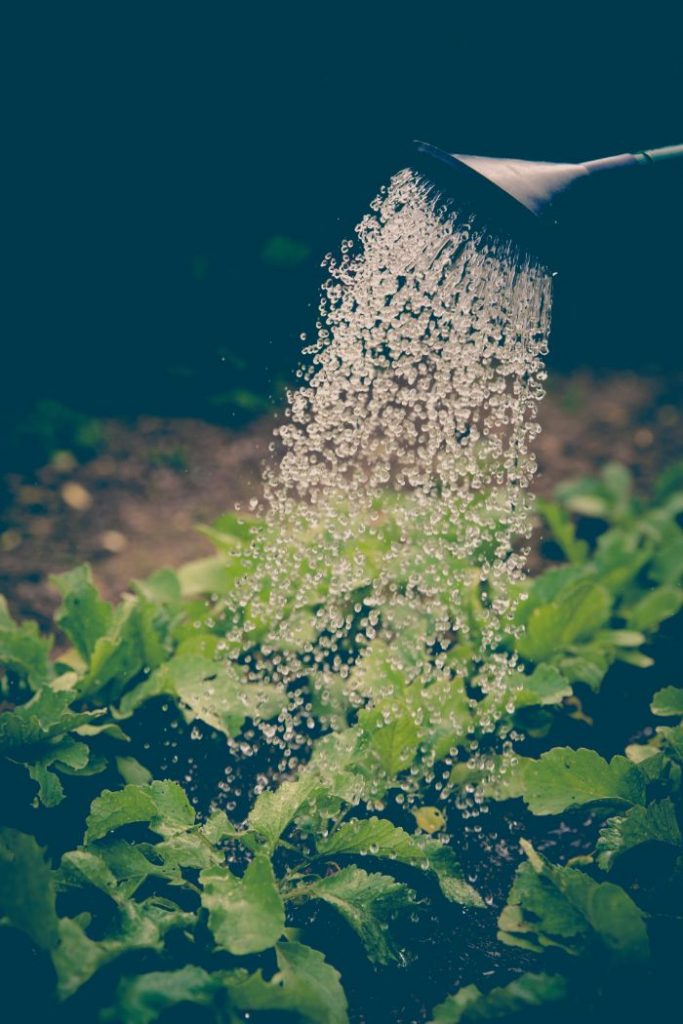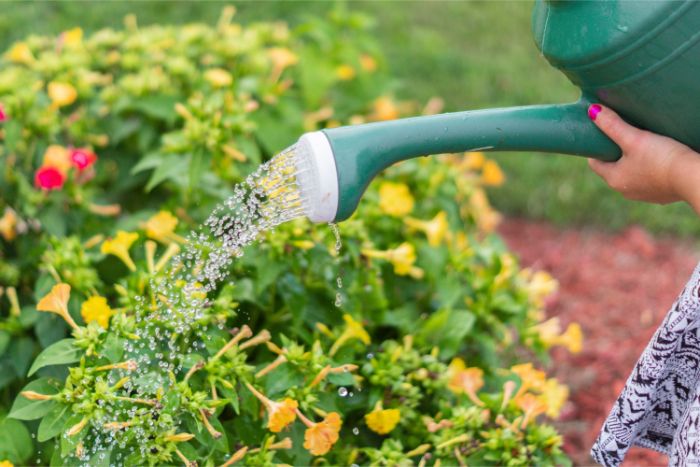When I talk to other gardeners about the best time of day to water plants, there always seems to be a lot of confusion. There are quite a few myths about the time of day and technique for watering. In this article, I’ve sorted fact from fiction about the best time to water plants.
What’s the best time of day to water plants? The best time of day to water plants is in the morning before the sun becomes hot. This lets your plants absorb water without excess loss to evaporation, while ensuring the foliage has dried before nighttime, reducing the risk of plant diseases.
Why Should You Water Your Plants In The Morning?
Every gardener wants their plants to thrive and look their best. And yet sometimes it can be hard to know the right thing to do to keep your plants looking their best. And yet if we think about it a little, it makes sense that watering in the morning is the best strategy.
Here are some of the main reasons why watering plants in the morning is best;
- Early morning watering prevents excessive evaporation, which can waste large amounts of water.
- Foliage has plenty of time to dry before the evening, preventing fungal and bacterial diseases from developing.
- Plants absorb water most rapidly during the day, so more is absorbed by the roots, instead of being lost into the soil.
When you water your plants, the water will start to be absorbed into the soil and much of it can quickly move out of range of the roots. Watering your plants in the morning, when their growth rate and metabolism is increasing, is ideal, as their water requirements will be rising and the roots will be ready to absorb water.
In addition, in the early morning, the sun will be relatively cool, and surface water will be less likely to evaporate. Both these factors will ensure that there is plenty of water available for your plants.
As the day progresses, and the heat of the day reaches it’s maximum, excess water on the foliage will evaporate. This is important, as it means that as the day ends, there will not be excess water on the leaves and stems of your plants. Fungal and bacterial diseases love moist environments, so plant leaves that remain wet overnight can attract nasty diseases which can quickly destroy your beautiful plants.
Is It OK To Water Plants In The Evening?
Despite what I’ve said about watering in the morning, you have to remember why you water your plants in the first place. Water is essential to their survival, and whilst watering in the morning is generally best, if your plants are crying out for a drink, it’s better to water them regardless of the time of day, rather than waiting for the perfect moment to give them some water.
However, you will need to be a bit more cautious when watering plants in the evening or at night. Ideally, if watering at night, you should take care to only water around the roots and avoid getting water on the leaves, where it can pool within the foliage.
If your plants are in real need of moisture, and the soil is dry, you are much better watering them, than letting them dry out further. Watering onto dry soil is much less likely to cause problems. It is a much greater risk where nighttime watering is done in combination with overwatering, as the plant will already be at risk of disease, and watering at night only makes this worse.
You need to be even more careful with houseplants when watering at night. The main reason for this is ventilation. Outside, the rate of evaporation will almost always be higher due to air movement. Inside air ventilation can be very poor, so the humidity levels in the immediate vicinity of your houseplants can be very high, and with the falling temperatures of night, evaporation can entirely cease.
If you are concerned about the foliage of your houseplants being wet in the evening, you could think about improving the ventilation by opening a window or putting a fan on nearby, which would significantly reduce the risk of problems.
Best Time To Water Plants In Hot Weather
The same rules apply to watering plants in hot weather as cool weather, but contrary to the popular myth, it is safer to water your plants in hot weather than in relatively cool weather.
Many people have been told that water droplets on a plant in very hot weather can act like little magnifying glasses and scorch your plants. Well thankfully, there is no truth to this old myth. If your plants can tolerate hot weather when the foliage is dry, they will be no worse off when the foliage is wet.
The main reason why watering in hot weather is not recommended is due to the rate of evaporation. The rate of evaporation in hot weather is much higher and humidity is often lower. This means more of the water than you provide for your plants will evaporate into the air, rather than being made use of by your plants.
With so many parts of the world experiencing water shortages, it is really inefficient to water your plants in the heat of the day and wastes a large amount of water.
Should You Water The Leaves Of A Plant?
Whilst some plants can absorb water through the stomata on their leaves, the vast majority of water is absorbed through the roots. Watering leaves can help to remove dust from the foliage, but rain will do this for you for your outdoor plants, so there is no need.
If you water your plants during the day, feel free to water the foliage, as this will do no harm. If watering houseplants or outdoor plants in the evening, avoid watering the foliage for most plant species, as this will predispose to opportunistic fungal and bacterial diseases.

How Often Should You Water Plants?
Most attentive gardeners struggle to fight the urge to overwater their plants. For the majority of indoor and outdoor plants, it is best to allow the plant and soil to dry out fairly well and then to water thoroughly.
Watering plants small amounts on a frequent basis discourages them from developing a deep and robust root system.
When I see people struggling with how often to water their plants, there tend to be two extremes. Firstly, there are people with good intentions, myself included, who tend to struggle to remember that too much water can be a bad thing.
Then there are people who just get out of the habit of watering their plants, or forget a little too often. This is particularly easy to do with houseplants and potted plants. It’s so easy to buy a beautiful houseplant at the store, put it in pride of place in your home, and then forget all about it until its too late.
I see this frequently, and I have an annoying habit of watering other people’s houseplants when I visit them. I hope people take this the right way!
Where I work, we have quite a few indoor plants, and I have to regularly inspect them to see if they are being killed with kindness or completely neglected. I do an unofficial plant rescue mission on a regular basis.
Do I Need To Water Drought Tolerant Plants?
Plants that are adapted to living in hot, arid conditions can certainly tolerate less frequent watering, but in periods of excessive dryness, they are still going to need watered. Also, in their first few years, or after repotting, their root system will be poorly developed and you’ll need to provide some extra TLC to make sure they grow up big and strong.
Best Time To Water Indoor Plants
The timing of watering indoor plants is even more crucial than outdoor plants. Inside, without rainfall, your plants are completely reliant on you for their water and wellbeing. In addition, with lower ventilation, they are so much more sensitive to overwatering or watering at the wrong time of day.
The best time of day to water houseplants is the morning, just like outdoor plants. Don’t water your houseplants on a schedule, as every plant and home environment will be different.
Instead, observe your plant and learn how it reacts to your care. Watch for signs it needs water. Monitor the dryness of the potting medium and condition of the foliage.
I often use the weight of the pot as a guide to help me know when my houseplants need watering. If you lift the pot to check it’s weight, over time you will be able to tell with a reasonable degree of certainty when the potting media is getting dry.
In addition, poke a finger into the potting material and feel the moisture in it. Learn how moist your plants like their potting soil to be and water according to their needs.
What Causes Plants To Wilt?
If you are observing your plants for signs they need watered, you may see them start to wilt at times. However, bear in mind that this only means that the leaves are not getting enough water, not necessarily that there is not enough water in the soil.
Wilting can be due to root rot caused by overwatering. In this case, there is too much water, but the roots are unable to absorb it and the plant wilts.
Alternatively, various diseases and pests can also affect water absorption and cause the leaves to wilt, but this doesn’t always mean your plants need more water.
Wilting is a sign you should watch for, but you’ll need to assess multiple factors to see if your plants are craving water. Look at the leaves, stem and flowers, as well as feeling the soil before deciding if your plant needs water. Look for signs of pests and disease and be sure to treat promptly.
Want to learn more about looking after your plants? This website is full of plant care guides and gardening tips. Check out my newest articles here and check out my resources section if you want the tools and skills to grow amazing plants.

